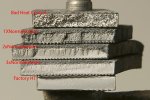Critical temperature I think refers to the temperature at which a phase is completed. I’ve heard it used mostly to refer to above Ac3 and sometimes the quench temperature.
Below Ac1 is referred to as sub-critical, above Ac1 is where austenite starts to form, above Ac3 is where you have complete transformation to austenite. Acm is the temperature at which all of the carbides are dissolved. Between Ac1 and Ac3 is called inter-critical.
Ac1, Ac3, etc. is used to note transformation temperature upon heating, Ar1 etc. is used to note transformation temperature upon cooling. A1 or Ae1 etc. is used for equilibrium temperatures.
Normalizing is done from the Acm temperature. I’ve seen studies where they air cool from Acm to form fine pearlite, and others where they quench from Acm to form fine carbides in martensite, both lead to fine grain after thermal cycling and quench and temper.
Critical temperature is reached above Ac3, so I’m not sure if decending temperatures are necessary instead of just cycling from critical temperature. I’ve never thought about this untill Larrin brought it up.
Hoss
Below Ac1 is referred to as sub-critical, above Ac1 is where austenite starts to form, above Ac3 is where you have complete transformation to austenite. Acm is the temperature at which all of the carbides are dissolved. Between Ac1 and Ac3 is called inter-critical.
Ac1, Ac3, etc. is used to note transformation temperature upon heating, Ar1 etc. is used to note transformation temperature upon cooling. A1 or Ae1 etc. is used for equilibrium temperatures.
Normalizing is done from the Acm temperature. I’ve seen studies where they air cool from Acm to form fine pearlite, and others where they quench from Acm to form fine carbides in martensite, both lead to fine grain after thermal cycling and quench and temper.
Critical temperature is reached above Ac3, so I’m not sure if decending temperatures are necessary instead of just cycling from critical temperature. I’ve never thought about this untill Larrin brought it up.
Hoss

